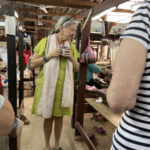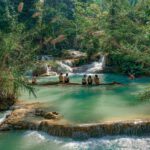Everything you need to know about Luang Prabang
Post on : 06 June, 2017 Luang Prabang, located in the north of Laos, is one of Indochina’s gems and one of the oldest province with dozens tourist attractions of the country. It was the capital of the Lane Xang Kingdom during the 13th to 16th centuries. In 1995, Luang Prabang was listed by UNESCO […]
Luang Prabang, located in the north of Laos, is one of Indochina’s gems and one of the oldest province with dozens tourist attractions of the country. It was the capital of the Lane Xang Kingdom during the 13th to 16th centuries. In 1995, Luang Prabang was listed by UNESCO as a World Heritage Site for unique architectural, religious and cultural heritage, as well as a blend of the rural and urban developments over several centuries including the French colonial influences during the 19th and 20th centuries.
Square: 16,875 km2 (6,515 sq mi)
Population: 431,889 people (2015 census)
City: Luang Prabang
Districts: 12 districts: Luang Prabang, Xieng Ngeun, Nane, Pak Ou, Nambak, Ngoi, Pak Seng, Phonxay, Chomphet, Viengkham, Phoukhoune and Phonthong.

History:
Luang Prabang is the ancient capital of Lan Xang (“one million elephants”) and is one of the oldest cities in Laos, founded approximately 1,200 years ago. It was previously known by two other names, Muang Sawa (or Muang Sua) and Xieng Dong Xieng Thong.
After Lan Xang had troubles in 1707, Luang Prabang became the capital of the independent Luang Prabang kingdom. When France annexed Laos, the French recognised Luang Prabang as the royal residence of Laos. Eventually, the ruler of Luang Prabang became synonymous with the figurehead of the French Protectorate of Laos. When Laos achieved independence, the king of Luang Prabang, Sisavang Vong, became the head of state for the Kingdom of Laos. In 1941, following the Franco-Thai War, Thailand occupied part of the province, which was named Lan Chang Province. On March 9, 1945, independence was declared for Laos, and Luang Prabang was the capital. Colonel Hans Imfeld, commissioner of the French Republic, entered Luang Prabang on 25 August 1945 with a party of Franco-Laotian guerrillas and received assurances from the King that the protectorate was still in force. After the Washington Accord of 1946, the Thai government ceded the annexed territories of Luang Prabang and Xaignabouli provinces back to Laos.
Geography:
Luang Prabang covers an area of 16,875 square kilometres (6,515 sq mi). It borders Phongsali Province to the north, Vietnam (Dien Bien and Son La) to the northeast, Houaphan Province to the east, Xiangkhouang Province to the southeast, Vientiane Province to the south, Xaignabouli Province to the southwest, and Oudomxay Province to the west.
Climate & weather:
May is the hottest month in Luang Prabang with an average temperature of 29°C (84°F) and the coldest is December at 20°C (69°F) with the most daily sunshine hours at 9 in April. The wettest month is August with an average of 288.6mm of rain.
The coldest is December at 20°C (69°F) with the most daily sunshine hours at 9 in April. Finally, the wettest month is August with an average of 288.6mm of rain.
Activities & Tourist attractions:
There are a lot of place for you to visit as well as activities for relaxing. Royal Palace, the national museum in the capital city is one of the can-not-be-missed destination. Notable temples in the provinces are the Wat Xieng Thong, Wat Wisunarat, Wat Sen, Wat Xieng Muan and Wat Manorom.
Every morning, visitors can enjoy the sights of monks collecting alms, join outdoor activities such as rock climbing in Vang Vieng, mountain biking, caves visiting, elephant ride, rafting, trekking and contemplating the imposing scene of City.
Cuisine:
Lao cuisine resembles the food of neighbouring countries, with Indochinese presentation and Thai components occasionally overlapped by French influences. Sticky rice is the nation’s staple, closely followed by noodle soup served with shredded beef or pork, known as pho. Other traditional Lao favourites include laap, minced meat or fish tossed with lime juice and herbs, and tam maal hung, spicy papaya salad. As with most dishes, sticky rice is always served with these two favourites.
Much of the cuisine here is very spicy, using liberal amounts of local herbs, vegetables and spices to create some truly unique dishes not found in other countries. Every town has a fresh food market, which is the best place to sample some of the more traditional Lao snacks and foods. Western restaurants can be found in the largest cities like Vientiane and Luang Prabang, and offer fairly basic menu items with the exception of some exclusive French restaurants.




